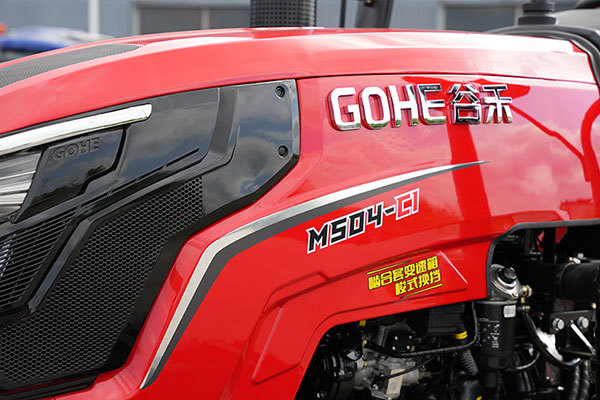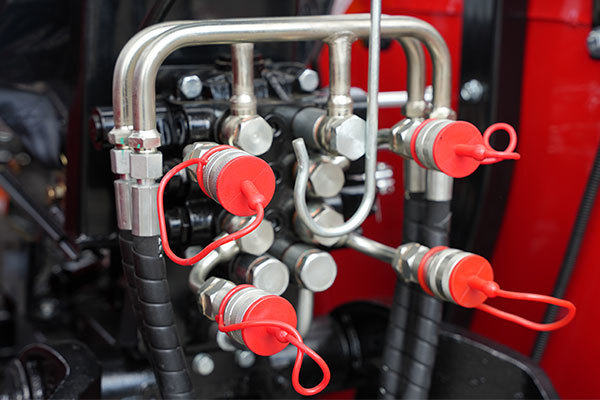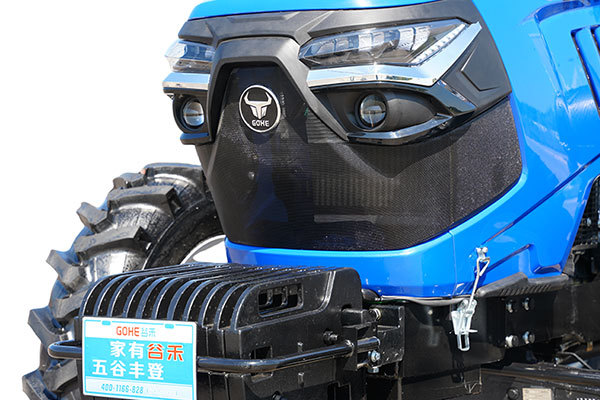The driving principle and influencing factors of tractor
Release time:
2024-09-30
The ability to travel relies on the power of the internal combustion engine through the transmission system
Driving principle
The ability to travel relies on the power of the internal combustion engine through the transmission system, which enables the driving wheels to obtain the driving torque Mk. The driving wheels that obtain the driving torque then apply a small, backward horizontal force (tangential force) to the ground through the tire tread and tire surface. The ground surface exerts a horizontal force Pk, which is equal in magnitude but opposite in direction to the driving force. This Pk force is the driving force that drives the tractor forward (also known as the propulsion force). When the driving force Pk is sufficient to overcome the forward rolling resistance of the front and rear wheels and the traction resistance of the carried agricultural tools, the tractor moves forward. If the driving wheel is lifted off the ground, that is, the driving force Pk is zero, the driving wheel can only spin in place and the tractor cannot move; If the sum of rolling resistance and traction resistance is greater than the driving force Pk, the tractor cannot move. It can be seen that the driving of wheeled tractors is achieved by the interaction between the driving torque driving wheels and the ground, and the driving force is greater than the sum of rolling resistance and traction resistance.
influence factor
1. Rolling resistance. The rolling resistance of a tractor is mainly caused by the deformation of the tires and soil. Under the weight of the tractor, the tires are flattened and the soil is compacted. During the rolling process, the various parts of the tire that come into contact with the ground along the circumference of the circle are continuously flattened and deformed, and the soil that is higher in front of the wheel is pressed down to deform the soil and form a wheel track, which generates rolling resistance that hinders the forward rolling of the wheel. There are many factors that affect rolling resistance, mainly related to the size of the vertical load on the solid and moist ground. For the same tractor, if the ground conditions are different, its rolling resistance is also different. For example, when driving on asphalt, cement, or dry hard ground, the rolling resistance is small, and the tractor traction is large. Under the same usage conditions, the greater the weight added to the tires, the greater the vertical deformation of the soil, and the greater the rolling resistance. Generally speaking, reducing the deformation of the tire itself and the vertical deformation of the soil is beneficial for reducing rolling resistance. If the tractor is driven on soft ground, using low-pressure tires and increasing the tire support area can reduce soil deformation in the vertical direction, lower rolling resistance, and thus improve traction. Due to the fact that tractors are mainly used for field operations and often drive on soft ground, in order to reduce soil deformation in the vertical direction, tractors generally use the lowest pressure tires, and the same principle applies to widened tires. We should pay attention to the differences in the use of low-pressure tires, widened tires, and high-pressure tires in our operations.
2. Traction resistance. Traction resistance is the resistance that a tractor needs to overcome to drive agricultural machinery during operation. It is equal to the traction force transmitted by the tractor to the agricultural machinery through a connecting device. Since traction is equal to driving minus rolling resistance, increasing driving force and reducing rolling resistance are effective measures to improve traction.
3. Driving force. It is the horizontal reaction force of the road to the driving wheel. Therefore, the magnitude of the driving torque Mk transmitted by the internal combustion engine to the driving wheels through the transmission system indicates that the driving force Pk of the tractor is also greater. However, since Mk is determined by the power of the internal combustion engine, Pk is also limited by the power of the internal combustion engine. At the same time, Pk is limited by soil conditions and cannot be infinitely increased, because when the soil's reaction force, i.e. the driving force Pk, increases to a certain extent, the soil is destroyed, the driving wheel slips severely, and the driving force Pk cannot be increased any further. We call the maximum reaction force that the soil can produce on the driving wheel "adhesion". From this, it can be seen that the maximum value of the driving force Pk is not only limited by the internal combustion engine rate, but also by the soil adhesion, and cannot be infinitely increased.
Adhesion reflects the ability to generate maximum driving force between the driving force and the soil. There are many factors that affect adhesion, mainly related to ground conditions, tire pressure, size, pattern, and the magnitude of the vertical load acting on the tire. For tractors, reducing tire pressure, increasing tire support area, improving wheel grip on soil, and increasing wheel attachment weight within a certain range under certain soil conditions are all beneficial for improving tractor adhesion. Low pressure tires are commonly used on tractors, and some tractors use widened tires and high tread tires, as well as adding counterweights to tractor drive wheels, all of which are measures taken to increase tractor adhesion and improve tractor traction capacity. However, it should be pointed out that adding counterweight iron to the driving wheel can increase adhesion, but at the same time, it also increases soil deformation in the vertical direction and increases rolling resistance. Therefore, whether to add counterweight iron depends on specific usage conditions and the overall effect should be weighed before making a decision.
The maximum adhesion capacity and ability to resist slipping between the driving wheels of a tractor and the ground are called the tractor's adhesion performance. If the adhesion performance is good and the slip is light, the driving torque can be fully utilized, and the ability of the internal combustion engine can also be fully utilized, making the tractor look powerful during operation. If the adhesion performance is poor and the slip is severe, the driving torque cannot be fully utilized, the capacity of the internal combustion engine cannot be fully utilized, and the tractor appears to be powerless during operation, or in other words, the tractor does not have much power. Severe slippage of the driving wheels can reduce the speed of the tractor, decrease production and economy, and accelerate the wear of the driving wheel tires. In addition, the structure of the soil can also be damaged.
Related News





